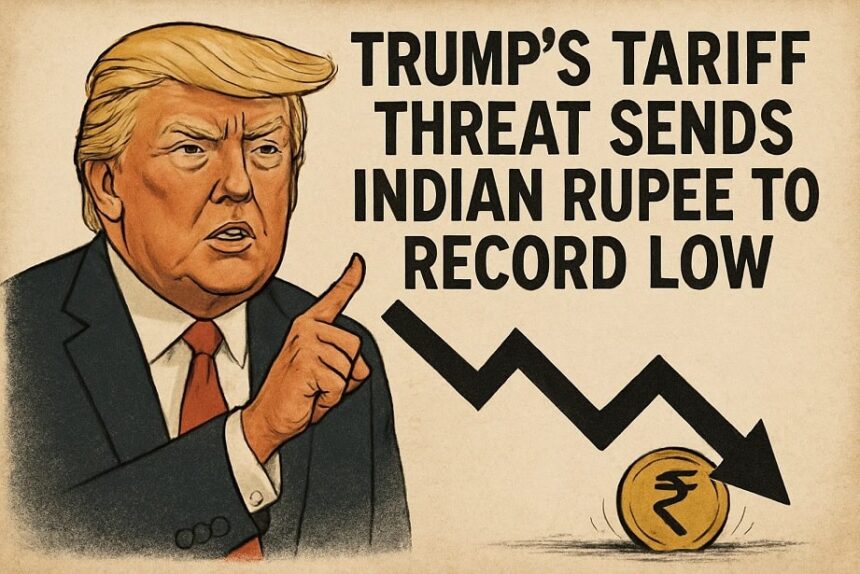On August 5, 2025, the Indian rupee plummeted to a record low of 88.10 against the U.S. dollar, driven by U.S. President Donald Trump’s threat to “substantially” increase tariffs on Indian goods due to India’s continued purchases of Russian oil. The currency, which opened at 87.85 after closing at 87.66 the previous day, breached its prior record low of 87.95 from February 2025. The Reserve Bank of India (RBI) likely intervened to cap the decline, stabilizing the rupee at 87.85 by Tuesday’s open. This escalation, following a 25% tariff imposed on August 1, 2025, and an additional penalty tied to India’s trade with Russia, has heightened U.S.-India trade tensions and sparked fears of economic fallout.
Background of the Situation
The rupee’s slide began intensifying after Trump’s August 4 announcement on Truth Social, where he accused India of profiting from Russian oil purchases amid the Ukraine conflict. He threatened to raise tariffs beyond the 25% rate effective August 1, citing India’s high tariffs on U.S. goods and its energy and military ties with Russia, including purchases of the S-400 missile system. India’s Ministry of External Affairs (MEA) responded on August 5, calling the threats “unjustified and unreasonable,” noting that the U.S. and EU also import Russian energy, with EU-Russia trade reaching €67.5 billion in 2024. The MEA emphasized India’s energy security needs, as Russian oil accounts for 35% of its crude imports (1.75 million barrels per day in H1 2025).
Key Economic Indicators | Details |
|---|---|
Rupee Value (August 5, 2025) | 88.10 (record low, intra-day) |
Previous Record Low | 87.95 (February 2025) |
Monday Close | 87.66 |
Tuesday Open | 87.85 |
U.S.-India Trade (2024) | $130 billion (U.S. deficit: $45.8 billion) |
Foreign Equity Outflows (2025) | $11 billion |
India’s $130 billion trade relationship with the U.S., marked by a $45.8 billion U.S. trade deficit in 2024, is at risk. Key Indian exports like pharmaceuticals, textiles, and smartphones face higher costs, potentially impacting U.S. consumers. The rupee’s decline reflects fragile market sentiment, exacerbated by $11 billion in foreign equity outflows in 2025 and slowing economic growth.
Economic and Market Impact
The rupee’s record low has significant implications:
- Indian Economy: Analysts at Nomura estimate that the 25% tariff and additional penalties could reduce India’s GDP by 0.2-0.4% in 2025-26. Sectors like jewelry ($10 billion in exports) and smartphones face risks, with potential job losses in labor-intensive industries.
- U.S. Consumers: Tariffs, paid by U.S. importers, could raise prices for Indian goods like pharmaceuticals and textiles. A Yale Budget Lab report predicts U.S. consumers could lose $2,400 annually due to price hikes, with clothing costs rising 38% and shoes 40%.
- Equity Markets: Indian equity indexes, like the Nifty 50, fell 0.9% on July 31, with further declines on August 5 as tariff fears grew. Foreign institutional investors withdrew over ₹27,000 crore ($3.2 billion) in nine days, driven by tariff uncertainty and weak Q1 earnings.
- Rupee Pressure: The rupee’s fall was amplified by a strong dollar index (up 0.3% to 106.3) and expectations of no U.S. Federal Reserve rate cut in September, reducing support for emerging market currencies.
The RBI’s intervention, leveraging near-record foreign exchange reserves, prevented a breach of 88, but analysts warn of continued pressure. Deutsche Bank and Barclays predict the rupee could hit new lows by year-end, with Michael Wan of MUFG Bank forecasting 87 by December if a trade deal materializes.
India’s Response and Strategy
India’s government is pursuing a multi-pronged response:
- Diplomacy: The commerce ministry is studying the tariffs’ impact and exploring concessions, such as increased U.S. imports of natural gas and communication equipment, to secure a trade deal. Immediate retaliation is unlikely, with hopes of a delayed agreement.
- Oil Diversification: Indian refiners have boosted U.S. crude imports by 50% and Brazilian imports by 80% in 2025, but long-term Russian contracts limit a full shift. Oil Minister Hardeep Singh Puri emphasized India’s diversified oil sources (40 countries) and reserves (15 days to 3 months).
- RBI Intervention: The RBI’s suspected dollar sales stabilized the rupee, but Citigroup economists note that tariff uncertainty may limit aggressive action.
India defends its Russian oil purchases, citing global market disruptions post-Ukraine invasion and the need for affordable energy. The MEA highlighted that EU’s Russian LNG imports hit 16.5 million tonnes in 2024, far exceeding India’s trade volume with Russia.
Geopolitical Context
Trump’s tariffs are part of a broader strategy to pressure countries trading with Russia, tied to his August 8 deadline for a Russia-Ukraine ceasefire. Earlier threats of 100% tariffs on Russian oil buyers like India and China have intensified, with Trump labeling India’s economy “dead” and criticizing its BRICS membership. India’s non-aligned stance, balancing ties with Russia and the West, complicates negotiations. The Indian National Congress criticized the government’s handling of U.S. relations, calling the tariffs a “catastrophic failure of foreign policy.”
Other Asian nations like Japan, Vietnam, and the Philippines secured lower tariffs (15-20%), while India’s stalled talks have left it facing 25% tariffs and potential increases. Trump’s focus on reducing the $45 billion U.S.-India trade deficit and India’s high tariffs (12% trade-weighted average) adds further strain.
Market Sentiment and Outlook
Market sentiment is fragile, with traders expecting further rupee depreciation. A senior FX trader noted, “Trump’s latest tariff threat amplified the pressure,” predicting increased equity outflows if tensions persist. Posts on X reflect mixed views, with some calling Trump’s rhetoric a negotiation tactic, while others urge India to counter with restrictions on U.S. firms.
Analysts remain cautiously optimistic about a trade deal, with India offering tariff reductions on U.S. goods like Bourbon whiskey and motorcycles. However, Trump’s insistence on agricultural market access and high tariffs under any agreement remains a hurdle. The RBI’s monetary policy meeting on August 6 may see a rate cut to counter economic headwinds, but this could further weaken the rupee.
Impact
Trump’s tariff threats have pushed the Indian rupee to a record low, intensifying economic and geopolitical tensions. India’s robust response, backed by RBI interventions and diplomatic efforts, aims to mitigate the impact, but the threat of higher tariffs looms large. The outcome of trade talks and the August 8 deadline will be critical, with potential consequences for global trade, oil prices, and U.S.-India relations. As India balances its energy needs and strategic autonomy, the world watches to see if a deal can avert further economic disruption.












